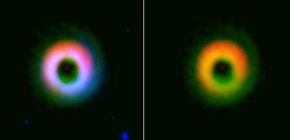
ALMA Discovers Formation Site of a Giant Planetary System
Discovery making a transformative impact on theories of planet formation
A team of Japanese astronomers has obtained firm evidence of the formation of a giant planetary system around a young star through observations made with the Atacama Large Millimeter/submillimeter Array (ALMA). This result has made a transformative impact on theories of planet formation and provides clues regarding the origin of a wide variety of planetary systems.
The research team, led by astronomers at Osaka University and Ibaraki University, observed a young star named HD142527 in the constellation Lupus (the Wolf) with ALMA. The ALMA image shows that cosmic dust, a component material of planets, is circling around the star in an asymmetric ring. By measuring the density of the dust in the densest part of the ring, the astronomers found that it is highly likely that planets are now being formed in that region. That region is far from HD142527, about 5 times greater than the distance between the Sun and Neptune. This is the first firm evidence linking planet formation found at such a great distance from the central star in a protoplanetary disk. The research team plans further observations of HD142527 with ALMA for closer investigation, as well as of other protoplanetary disks, to help gain a comprehensive understanding of planet formation in general.
Abstract
We report ALMA observations of dust continuum, 13CO J=3--2, and C18O J=3--2 line emission toward a gapped protoplanetary disk around HD 142527. The outer horseshoe-shaped disk shows the strong azimuthal asymmetry in dust continuum with the contrast of about 30 at 336 GHz between the northern peak and the southwestern minimum. In addition, the maximum brightness temperature of 24 K at its northern area is exceptionally high at 160 AU from a star. To evaluate the surface density in this region, the grain temperature needs to be constrained and was estimated from the optically thick 13CO J=3--2 emission. The lower limit of the peak surface density was then calculated to be 28 g cm-2 by assuming a canonical gas-to-dust mass ratio of 100. This finding implies that the region is locally too massive to withstand self-gravity since Toomre's Q <~1--2, and thus, it may collapse into a gaseous protoplanet. Another possibility is that the gas mass is low enough to be gravitationally stable and only dust grains are accumulated. In this case, lower gas-to-dust ratio by at least 1 order of magnitude is required, implying possible formation of a rocky planetary core.

Figure 1

Figure 2
To learn more about this research, please read the full research report entitled " Local Enhancement of Surface Density in the Protoplanetary Ring Surrounding HD 142527 " at this page of the Cornell University Library website.
Related links
ALMA Discovers a Formation Site of a Giant Planetary System
Infrared Astronomy Group, Department of Earth and Space Science, Graduate School of Science, Osaka University
